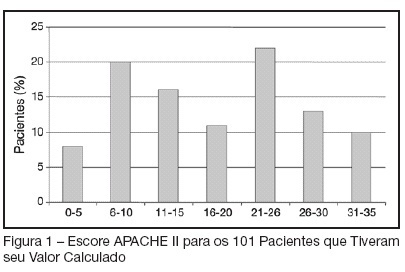Abstract
Rev Bras Ter Intensiva. 2007;19(4):414-420
DOI 10.1590/S0103-507X2007000400002
BACKGROUND AND OBJECTIVES: To determine the prevalence of intensive care unit (ICU)-acquired infections and the risk factors for these infections, identify the predominant infecting organisms, and evaluate the relationship between ICU-acquired infection and mortality. METHODS: A 1-day point prevalence study. Sixteen ICU of the State of Rio Grande do Sul-Brazil, excluding coronary care and pediatric units. All patients < 12 yrs occupying an ICU bed over a 24-hour period. The 16 ICU provided 174 case reports. Main outcomes: rates of ICU-acquired infection, resistance patterns of microbiological isolates, and potential risks factors for ICU-acquired infection and death. RESULTS: A total of 122 patients (71%) was infected and 51 (29%) had ICU-acquired infection. Pneumonia (58.2%), lower tract respiratory infection (22.9%), urinary tract infection (18%) were the most frequents types of ICU infection. Most frequently microorganisms reported were staphylococcus aureus (42% [64% resistant to oxacilin]) and pseudomonas aeruginosa (31%). Six risk factors for ICU acquired infection were identified: urinary catheterization, central vascular line, tracheal intubation for prolonged time (> 4 days), chronic disease and increased length of ICU stay (> 30 days). The risks factors associated with death were age, APACHE II, organ dysfunction, and tracheal intubation with or without mechanical ventilation. CONCLUSIONS: ICU-acquired infection is common and often associated with microbiological isolates of resistant organisms. This study may serve as an epidemiological reference to help the discussion of regional infection control policies.

Abstract
Rev Bras Ter Intensiva. 2007;19(1):23-30
DOI 10.1590/S0103-507X2007000100003
BACKGROUND AND OBJECTIVES: Verify the association between clinical, epidemiological and laboratorial characteristics with mortality of septic patient in an Intensive Care Unit (ICU) from Pernambuco, northeast of Brazil, to improve the attention for patients with sepse which are in risk of developing organ dysfunction. METHODS: Case-control study, without intervention, that included adults' patients admitted in ICU with sepsis or that developed it during ICU stay. RESULTS: It was included 199 patients. After logistic regression, the length of hospital stay more than 72 hours before admission in ICU, evidence of associated co-morbidities, more than three organ failures, and lactate more than 4 mmol/L were associated with mortality. The SOFA score with more than 12 points was associated with precocity mortality (< 72hours). CONCLUSIONS: The septic patients admitted ICU with less than 72h of hospital stay have a better prognosis, and those with a great number of organ failure, and co-morbidities have a superior mortality rate. Between laboratory results, only the high concentration of lactate is associated with mortality.